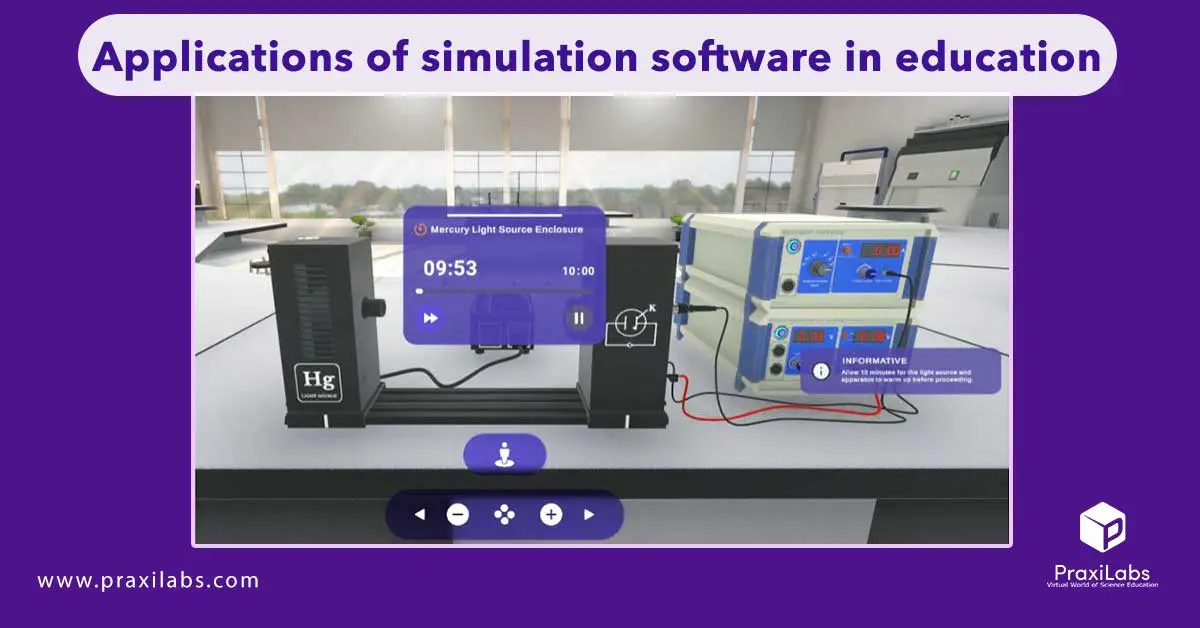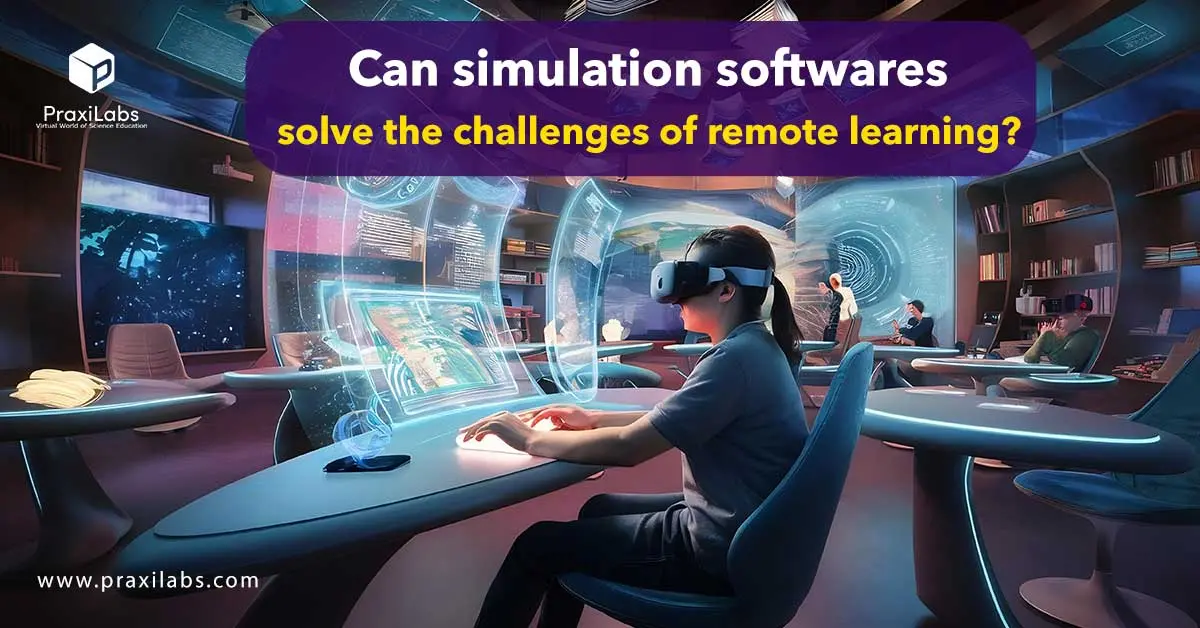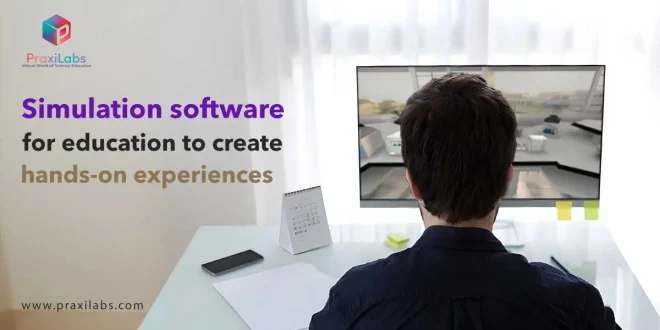Last Updated on October 29, 2025 by Muhamed Elmesery
In today’s education landscape, simulation software for education is transforming how students learn complex scientific and technical concepts. Unlike traditional learning, which relies heavily on lectures and physical experiments, simulations offer interactive, risk-free, and repeatable environments that enhance understanding and engagement.
In this blog post, we will explore what is simulation software for education, its advantages and applications, how scientific simulation is reshaping the concept of labs, a comparison between simulation Software and traditional learning, and why PraxiLabs is utilized by students, educators, and researchers.
Table of Contents
What is simulation software in education?
Simulation software for education is a simulation based learning tool that enables learners to interact with virtual environments and simulations to enhance their practice skills and learning outcomes.
These simulations use virtual interactive models to mimic real-world scenarios, allowing students to apply their knowledge in a safe, risk-free environment.
What are the advantages of simulation in education?
- According to a study that revealed multiple positive outcomes from using simulation software for education, these results align with findings from various academic sources.
- The increase in student achievement and the successful execution of applications, contributing to a sense of accomplishment, underscore the benefits of simulation-based learning.
- The practical application of theoretical knowledge facilitated by simulations significantly enhances students’ learning experiences, making them more effective and engaging.
- Students displayed a high level of proficiency with the simulation software for education despite using it for the first time.
- This finding corroborates research indicating that simulation tools can enhance technical skills and knowledge application in real-world scenarios.
- The ability of students to resolve issues arising during circuit connections and coding processes demonstrates the development of problem-solving skills, a critical aspect highlighted in previous studies.
- Additionally, simulation applications support the learning process by enhancing students’ critical thinking skills and self-efficacy.

Applications of simulation software in education
One of the most important applications of simulation software for education examples are virtual science labs.
Virtual Science Labs:
- By using these virtual labs, students can perform their experiments in a safe environment, at any time, and from anywhere, in peace and away from any risks.
- Virtual labs enhance learning engagement, boost student performance, and provide valuable insights for educational institutions and instructors.
- Virtual labs allow a unique opportunity through making mistakes with no potential safety hazards for students or any additional costs due to waste of materials and consumables.
- Virtual simulations address the limitations of traditional science labs such as safety hazards, high costs, ethical challenges e.g. animal testing, limited access for students, lack of engagement and student interest, and high student dropout rates.
How does scientific simulation is reshaping labs concept?
Scientific simulation labs prepare students for real laboratory work; they act as a training ground where students can explore, experiment, and make mistakes safely before stepping into a real laboratory.
Through guided, interactive science simulations, they learn the correct procedures, develop precision in handling equipment, and understand the logic behind each experimental step.
Comparison between simulation Software and traditional learning
| Aspect | Simulation Software Learning | Traditional Learning |
| Learning Environment | Virtual, interactive, and technology-driven | Physical classrooms and real labs |
| Accessibility | Accessible anytime and anywhere via computers or tablets | Limited to specific locations and schedules |
| Cost | Cost-effective (no need for consumables or lab maintenance) | High cost due to equipment, materials, and lab setup |
| Safety | 100% safe; no exposure to hazardous chemicals or lab accidents | Risk of accidents and exposure to chemicals or machinery |
| Flexibility | Students can repeat experiments multiple times | Experiments are limited by time and resources |
| Engagement | Highly engaging with visual and interactive elements | May rely more on lectures and passive observation |
| Error Tolerance | Students can make mistakes and learn without consequences | Errors can lead to wasted materials or failed experiments |
| Feedback | Immediate, data-driven feedback | Feedback depends on the instructor evaluation |
| Scalability | Easily scalable to large numbers of students | Limited by lab space and instructor availability |
| Realism | Simulates real-world phenomena with precision | Offers real physical experience but limited repetition |

Can simulation softwares solve the challenges of remote learning?
Simulation software for education improves the quality of education and solves several problems.
- Simulation software for students, remote learning using simulations has enhanced and stimulated self-learning, improved time management skills, and increased self-reliance in research and study. This, in turn, has had a significant positive impact on their professional and academic future.
- For teachers, the use of educational simulations has contributed to enhancing their efficiency. It has provided them with the opportunity to practice using digital tools, create interactive content, and diversify teaching methods. As a result, the digital proficiency of the teaching staff has increased.
The use of educational simulations has also helped change the educational culture and proved to students, teachers, and parents that distance learning is not just an alternative, but an effective tool that can be used on a permanent basis.
Why PraxiLabs is utilized by students, educators and researchers?
Many features make students, educators and researchers choose PraxiLabs as interactive software for education, these features include:
- Improved Learning: because students can use PraxiLabs anytime and anywhere, they can learn science in a way that’s comfortable for them and easier.
- Real-time 3D Interaction: One of the top platforms for scientific simulations is PraxiLabs. The 3D experiments feel real, almost like you’re in an actual lab
- Improved Engagement: Our simulations promote practical experience and enhance learning and understanding.
- Unique Experiences: PraxiLabs makes science entertaining and informative by improving student engagement with interactive components and gamified features.
Let’s take a look at PraxiLabs in numbers:
- +1,000 educational institutions.
- +200 simulation-based learning examples for experiments across more than 20 branches of science.
- Over 1 million students worldwide benefit from our virtual simulations for experiments.
- More than 100,000 students benefit from our free accounts.
- +10 global partners.
- Over 6,000 participants in our webinars.
Frequently Asked Questions
What is simulation in simple words?
Simulation is the realistic re-enactment of real-world scenarios for various reasons, including entertainment, education, and preparing for an anticipated event.
What are the advantages of simulation as a tool for research and education?
Simulations provide a safe and cost-effective environment for practicing skills without real-world consequences, improving understanding of complex concepts through interactivity, and enabling researchers to test scenarios that are impossible or too expensive in reality.
Which software should I use to create physics simulations?
It depends a lot on which level of physics you want to simulate (educational, research, game-engine, robotics, molecular, multi-physics, etc.), your programming skills, and your budget (free vs commercial).
 PraxiLabs A virtual world of science
PraxiLabs A virtual world of science






